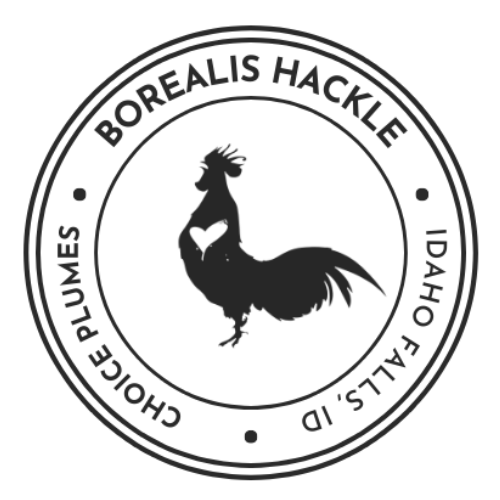Hackle from a genetic rooster is our bread & butter natural material when tying dry flies. The genetic variety are more than those simple, fallen feathers you find in the coop or around the farm. Though similar in structure and from the naked eye, it’s much more involved than that.
Darbee, Hoffman, Whiting, Collins, are just a few familiar names of the past and present that have contributed to the development of genetic hackle. Google them.
With each generation, selective breeding is practiced by a hackle grower to achieve specific traits or mutations in feather quality, length of usable feather, what we call “rachis” or stem and other characteristics. If we haven’t reached nerd mode yet, I haven’t served my purpose. Please continue reading! Today we’ll go over “barb count” real briefly.
These characteristics are no mystery to the avid fly tier, but can be confusing for the new beginner. I’ll explain a little deeper.
Every Dick, Joe & Karen that watches YouTube fly tying videos will have exposure to many different techniques, methods, and ways of skinning the cat. Meow! They are very educational and of value for the beginning fly tier, yet there are a few things that could show improvement. One that comes to mind is proper terminology. Inconsistencies in terminology = misunderstandings and misinterpretation.
A shining example of this is when referring to “barbs” as “fibers”. Is it a big deal in the whole game of fly tying? Not really. But, here I am making a big deal of it hahahahahahaha. Once you done been ignorant and then become edumacated, you’ll start to see and speak things differently. The great fly tier, Wayne Luallen, quickly and graciously educated me once on the matter. “Barbs”, not “Fibers”. Noted.
Barbs are just that. Barbs. The micro, tapered “hairs” running perpendicular to the center of a feather are made of a natural substance called keratin. What the average cat would see as insignificant in nature, we as flytiers and flyfishermen really have a laser focus on these little “hairs”. Have I weirded you out yet? Good, follow along then.
Barbs, when wrapped on a hook, act as support for our dry flies on the water or in the water’s film; propping them up to create the illusion of life. They can give the impression of legs, wings, or even a tail when multiple barbs are tied along the top/rear of the hook. Let’s get to the nitty gritty.
BARB COUNT: Closely observe the barbs when selecting hackle for your needs. Bend it like Beckham against a lighter surface to expose the barbs. Take an inch of hackle, and count the number of barbs along the stem (You might need a magnifier) How many of those little barbs do you count? Voila, this is called “barb count”. The higher the count doesn’t necessarily mean better hackle. Yes, too many barbs can be undesirable just as too low of a barb count. So, think of each pelt from Borealis Hackle as a big ‘ol bowl of porridge-not too hot and not too cold, but just right for your liking. Ya dig?
SIDE NOTE: Barb counts on barnyard birds are significantly lower in both count and quality, hence why they aren’t considered suitable for tying dry flies. However, don’t let that discourage you from using barnyard hackles every once in a while with a glass of sweet tea and some afternoon sunlight on the vise. All hackles have worth and value.
Hopefully this helps remove a little of the mystery out of genetic hackle for beginning fly tiers. But, wait, that’s not all. More to come.
Barbs not fibers,
Grant Bench
Borealis Hackle

